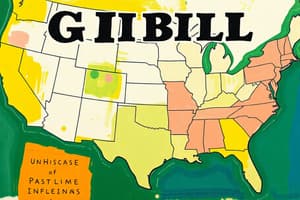Podcast
Questions and Answers
What major event contributed to the economic boom in America after World War Two?
What major event contributed to the economic boom in America after World War Two?
- The rise of the baby boom generation
- The introduction of the G.I. Bill of Rights (correct)
- The beginning of the Cold War
- The establishment of the United Nations
Which of the following was NOT a feature of the American dream in the post-war period?
Which of the following was NOT a feature of the American dream in the post-war period?
- Home ownership in suburbs
- Aspiration for success and happiness
- Access to consumer goods
- High levels of unemployment (correct)
What was a direct outcome of the baby boom generation in the United States?
What was a direct outcome of the baby boom generation in the United States?
- Increased political activism
- Decreased demand for housing
- Emergence of new forms of government
- Mass production of homes (correct)
What impact did the Federal Aid Highway Act of 1956 have on American life?
What impact did the Federal Aid Highway Act of 1956 have on American life?
What characterized the political climate in America after World War Two?
What characterized the political climate in America after World War Two?
What was a significant benefit of the economic recovery post-World War Two?
What was a significant benefit of the economic recovery post-World War Two?
How did the post-war economic conditions affect American consumer behavior?
How did the post-war economic conditions affect American consumer behavior?
Which aspect was a key feature of suburban life in the post-war era?
Which aspect was a key feature of suburban life in the post-war era?
Which president succeeded Franklin D. Roosevelt and was elected in 1948?
Which president succeeded Franklin D. Roosevelt and was elected in 1948?
What type of cultural shift occurred in America during the post-war period?
What type of cultural shift occurred in America during the post-war period?
Flashcards
Economic Boom
Economic Boom
A period when the economy expands and grows.
American Dream
American Dream
The idea that everyone in the USA has the chance to be successful and happy if they work hard.
Recession
Recession
A time of temporary economic decline when trade and industrial activity are reduced.
Federal Government
Federal Government
Signup and view all the flashcards
Suburbs
Suburbs
Signup and view all the flashcards
Consumerism
Consumerism
Signup and view all the flashcards
Living Wage
Living Wage
Signup and view all the flashcards
Baby Boomers
Baby Boomers
Signup and view all the flashcards
Levittowns
Levittowns
Signup and view all the flashcards
Federal Aid Highway Act
Federal Aid Highway Act
Signup and view all the flashcards
Study Notes
Post-World War II Economic Boom
- Economic recovery after WWII led to new opportunities and hopes.
- This period also saw political tension and the rise of civil rights activism.
- An economic boom created a new American dream of a comfortable life through hard work.
- Millions experienced a more attainable American dream.
- Peace and prosperity were enjoyed along with new forms of popular culture.
Post-War Economic Measures
- The 1944 G.I. Bill of Rights helped to prevent a post-war recession by funding education, training, housing, and business loans for veterans ($13 billion spent by early 1950s).
- Record birth rates in 1946 created a "baby boom" and increased demand for housing.
- Mass-produced houses were created in suburbs (e.g., Levittown) with white picket fences and modern appliances.
- Homeownership in suburbs became a key aspect of the American dream.
- Increased consumerism (refrigerators, cars, and television) was fueled by suburban growth.
Post-War Infrastructure and Lifestyle
- The Federal Aid Highway Act of 1956 improved road networks and enabled easier access to shopping malls, drive-in theaters, and restaurants.
- The increase in road construction connected the country and improved access to various commodities
Political Landscape
- Harry S. Truman succeeded Franklin D. Roosevelt.
- Truman was elected president in 1948.
- Truman continued Roosevelt's New Deal and started his "Fair Deal" with mixed success.
- The Fair Deal sought social reform but had mixed results.
Studying That Suits You
Use AI to generate personalized quizzes and flashcards to suit your learning preferences.




